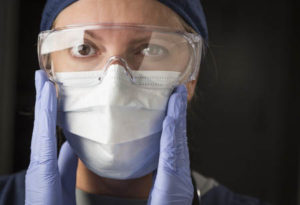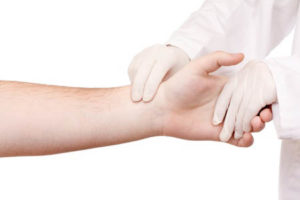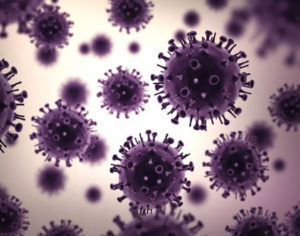Your cart is currently empty!
A Nurse’s Guide to Isolation Precautions
Nurses are among the most impacted by patients with infections or illnesses that warrant additional precautions. Thus, these health care professional need to understand the epidemiology of the most common infections, how to address unique isolation needs and how they relate back to best practices and delivery on successful treatment outcomes.

How Often Are Patients Suffering From Illnesses Requiring Isolation?
This depends on the type of illness being referenced. In general, up to 7 percent of patients, or 10 percent in developing countries, may contract a health-care associated infection, including infections that would have been prevented through the use of appropriate isolation precautions, reports the World Health Organization (WHO).
Among these, influenza and C. diff remain the most prevalent. However, a common component of infections that warrant isolation is their ease of transmission and access to other people that lack immune system strength to fend off the infection.
 Contact Isolation Precautions
Contact Isolation Precautions
Common reasons for contact isolation include illnesses with a high-risk transmissibility, such as C. diff, Herpes simplex virus, scabies, MRSA or even fungal infections.
Contact isolation precautions revolve around the most common method of transmission for pathogens, direct or indirect contact. Direct contact transmission is the result of transference of pathogens from one person to another person with a contaminated intermediary, such as floor or table.
 Droplet Isolation Precautions
Droplet Isolation Precautions
Illnesses spread by droplets include and are not limited to influenza, rhinovirus, pertussis and group A streptococcus.
Droplet isolation precautions are used when pathogens are small enough to be dispersed into the air when coughing or sneezing. However, they do settle on surfaces, and some pathogens may also be transmitted via direct contact. So, droplet isolation precautions should include the use of all appropriate measures as identified in the section entitled, “Contact Isolation Precautions.” Additional isolation measures included under droplet precautions include the following:
1. Wear A Mask
The typical, yellow-colored mask used for procedures is essential to preventing droplet transmission. The mask should be applied before opening the door to a patient’s room, and should only be removed upon exiting the room.
2. Wear Goggles
The use of goggles to prevent droplet transmission via the eyes may depend on the specific policies of your facility. In many cases, a facility may require the use of a face shield and routine procedure mask in lieu of goggles.
3. Remove PPE and Perform Hand Washing After Completing Care and Leaving the Room
As with contact precautions, you should wash your hands with warm soap and water upon leaving the patient’s room.
There is not a standard distance that defines how far a droplet-borne pathogen may travel. Experts describe it as a “relatively short distance,” such as three feet. However, the higher concentration of droplet-borne pathogens in patient rooms may require the use of masks upon entry regardless of the distance to the patient.
Droplet size is key to determining if an infection falls under droplet or airborne precautions. Generally, droplets are defined as being greater than 5 µm in size, meaning their size enables long-term suspension in the air. Thus, transmission can be prevented by using a basic, protective mask. However, smaller size particles may penetrate these masks, pushing the level of precautions into the next category, airborne precautions.

Airborne Isolation Precautions
Common airborne infections include spores or desiccated nuclei of pathogens, such as spore of Aspergillus and tuberculosis.
Airborne isolation precautions are used to prevent transmission of droplet-borne pathogens of less than 5 µm and those that may be disseminated within a facility over distances more than 10 feet. In addition, droplet-borne or contact-based infections that desiccate, or dry out, on a surface can be aerosolized in an environment, increasing transmissibility.
1. The Patient Should Be in a Negative-Pressure Room
A negative-pressure room maintains a lower pressure via the ventilation system that prevents airborne pathogens form exiting the room through an opened door. This is comparable to the effect of a mild vacuum or feeling air rush into an enclosed when opening the doors.
2. Wear an Appropriate Respirator
Due to the decreased size of the infectious agents in airborne illnesses, such as spores or dried, aerosolized nuclei, a higher-level respirator is needed to prevent their inhalation. The respirator should have an NIOSH rating of N95 or higher, and the respirator should be applied prior to entering the patient room. Otherwise known as a “duck-billed” mask, the respirator should adhere to the face without obstruction. Therefore, caregivers wearing heavy makeup or those with excess facial hair may be susceptible to infection via airborne pathogens.
3. Dispose of PPE in the Adjunct Room, Not Another Patient’s Room
Most negative-pressure rooms have an adjunct room for donning PPE prior to entry. This room is part of the specialized ventilation system, and all PPE used in a negative-pressure room should be left on until the caregiver is within this room, having closed the patient’s primary room door. Handwashing should be completed within this room, and the specialized air ventilation system will draw airborne pathogens, explains the CDC, into the patient’s room and through external air filters.
Neutropenic and Radiation Precautions
Neutropenic precautions are used when a patient has a low number of neutrophils in their immune system, making them immunocompromised. Neutropenic precautions may be used for patients that have AIDS or who are on immunosuppressants.
Neutropenic precautions are comparable to contact precautions in reverse. For example, you may need to wear gloves or other appropriate PPE to prevent bringing contaminates into the patient’s room. In addition, fresh fruits or vegetables should not be included with patient meals. Neither flowers nor live gifts of any kind should be brought into the room. Wash your hands immediately prior to entering the room as well.
Protect Yourself, Your Patients and Your Family From Infection by Getting the Training You Need.
Radiation precautions are also similar to neutropenic precautions because radiation may result in neutropenia too. However, radiation precautions also mean that all materials brought into a patient’s room must stay for the duration or until removed by an appropriate person, such as a custodial member of nuclear medicine.
Depending on the level of radiation used, including the use of radiopharmaceuticals, reports the University of Iowa, time limits may be imposed for visitors and caregivers in both daily and weekly maximums. In addition, gowns, shoe covers or other PPE equipment may be required. The appropriate member of nuclear medicine will provide an exposure-guideline chart that will placed aside the patient’s door. Due to privacy laws, this chart may contain protected health information, and it may be placed inside the top shelf of the appropriate isolation cart.
Protect Yourself, Your Patients and Your Family From Infection by Getting the Training You Need.
Isolation precautions are only part of the battle in preventing the spread of infection in your role as a health care professional. Understanding bloodborne pathogens is critical to making the most out of this article on isolation precautions. In the interim, by taking these steps, you can help stop the spread of infection now.
5 responses
-
-
In what states is a nurse allowed to isolate a patient under suspicion of infection without a MDs order?
-
Each state in the United States has its own Registered Nurses COMAR or Standards to follow. For example, if you live in Maryland, you can be licensed there. I would suggest look up the Maryland Board of Nursing website and search for any standards question there. The national governing body is the American College of Nursing or ACON but there are no National standards, they handle Board tests and education.
Hope this information helped. If you have any other questions, you may send us an email to customerservice@nhcps.com
-
-
Can you become a nurse if you are on immunosuppressants after a kidney transplant?
-
Hi Arin. Yes, Nursing as a career is available to all different types of people with or without disabilities. There are many fields to work in and you would need to speak to your Nursing Education counselors for guidance on which fields and departments best suit your needs. Please reach out to our customer service at customerservice@nhcps.com if you need further assistance!
-







great info.